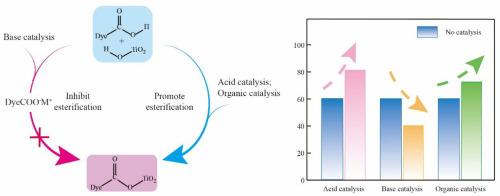优化染料锚定效率:酯化催化剂在羧基染料敏化TiO2光催化剂制备中的关键作用
IF 4.2
3区 工程技术
Q2 CHEMISTRY, APPLIED
引用次数: 0
摘要
染料敏化作为一种修饰TiO2光学性质的有效方法,在光催化和太阳能电池中有着广泛的应用。羧基功能化染料可以在TiO2表面形成稳定的酯键,有利于光生电子的转移。因此,酯化反应催化剂的加入必然会对增感过程产生影响。本研究系统地研究了酸性催化剂、碱性试剂和有机催化剂对羧基功能化染料敏化TiO2复合材料的催化作用,重点研究了它们的光催化性能及其机理。红外光谱表征结果证实染料成功锚定在TiO2表面并形成酯键。与碱类试剂对酯化反应的抑制作用不同,酸性催化剂和有机催化剂都能提高染料- tio2体系的酯化程度。紫外可见光谱结果表明,不同催化剂催化的染料-TiO2体系与纯TiO2相比具有明显的可见光吸收。值得注意的是,染料- tio2 (HNO3)和染料- tio2 (EDC-DMAP)分别在酸催化和有机催化体系中表现出最佳的可见光吸收。EIS证实,酸催化和有机催化都能降低染料- tio2体系的界面阻抗,这意味着更高的电荷转移效率和光催化活性。光催化实验也验证了上述特性。与染料- tio2相比,酸催化剂催化的染料- tio2体系表现出最好的光催化性能。在有机催化剂的催化下,染料- tio2体系的光催化效率也有所提高。相比之下,加入碱性试剂的染料- tio2体系的光催化性能低于未催化的染料- tio2体系。本文章由计算机程序翻译,如有差异,请以英文原文为准。

Optimizing dye anchoring efficiency: The critical role of esterification catalysts in carboxyl dye-sensitized TiO2 photocatalyst preparation
Dye sensitization, as an effective method to modify the optical properties of TiO2, has wide applications in photocatalysis and solar cells. Carboxy-functionalized dyes can form stable ester bonds on the TiO2 surface, which facilitates the transfer of photogenerated electrons. Therefore, the addition of esterification reaction catalysts inevitably influences the sensitization process. This study systematically investigates the catalytic effects of acid catalysts, basic reagents and organocatalysts on carboxy-functionalized dye-sensitized TiO2 composites, with a focus on their photocatalytic performance and underlying mechanisms. The infrared spectroscopy characterization results confirmed the successful anchoring of the dye on the TiO2 surface and the formation of ester bonds. Unlike the inhibition of esterification reactions by base reagents, both acid catalysts and organocatalysts led to higher esterification degrees in the dye-TiO2 system. UV–Vis spectra showed that the dye-TiO2 systems catalyzed by different catalysts exhibited distinct visible-light absorption compared with pure TiO2. Notably, dye-TiO2 (HNO3) and dye-TiO2 (EDC-DMAP) demonstrated the optimal visible-light absorption in the acid-catalyzed and organic-catalyzed systems, respectively. EIS confirmed that both acid and organic catalysis resulted in lower interfacial impedance in the dye-TiO2 system, implying superior charge transfer efficiency and photocatalytic activity. Photocatalytic experiments were also conducted to verify the aforementioned characteristics. Compared with dye-TiO2, dye-TiO2 system catalyzed by acid catalysts exhibited the best photocatalytic performance. The photocatalytic efficiency of dye-TiO2 system catalyzed by organocatalysts had also been improved. In contrast, the dye-TiO2 system involving basic reagents showed lower photocatalytic performance than the uncatalyzed dye-TiO2 system.
求助全文
通过发布文献求助,成功后即可免费获取论文全文。
去求助
来源期刊

Dyes and Pigments
工程技术-材料科学:纺织
CiteScore
8.20
自引率
13.30%
发文量
933
审稿时长
33 days
期刊介绍:
Dyes and Pigments covers the scientific and technical aspects of the chemistry and physics of dyes, pigments and their intermediates. Emphasis is placed on the properties of the colouring matters themselves rather than on their applications or the system in which they may be applied.
Thus the journal accepts research and review papers on the synthesis of dyes, pigments and intermediates, their physical or chemical properties, e.g. spectroscopic, surface, solution or solid state characteristics, the physical aspects of their preparation, e.g. precipitation, nucleation and growth, crystal formation, liquid crystalline characteristics, their photochemical, ecological or biological properties and the relationship between colour and chemical constitution. However, papers are considered which deal with the more fundamental aspects of colourant application and of the interactions of colourants with substrates or media.
The journal will interest a wide variety of workers in a range of disciplines whose work involves dyes, pigments and their intermediates, and provides a platform for investigators with common interests but diverse fields of activity such as cosmetics, reprographics, dye and pigment synthesis, medical research, polymers, etc.
 求助内容:
求助内容: 应助结果提醒方式:
应助结果提醒方式:


